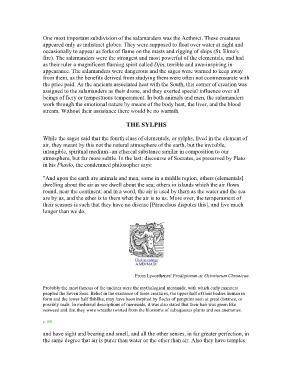Page 298 - The_secret_teachings_of_all_ages_Neat
P. 298
One most important subdivision of the salamanders was the Acthnici. These creatures
appeared only as indistinct globes. They were supposed to float over water at night and
occasionally to appear as forks of flame on the masts and rigging of ships (St. Elmo's
fire). The salamanders were the strongest and most powerful of the elementals, and had
as their ruler a magnificent flaming spirit called Djin, terrible and awe-inspiring in
appearance. The salamanders were dangerous and the sages were warned to keep away
from them, as the benefits derived from studying them were often not commensurate with
the price paid. As the ancients associated heat with the South, this corner of creation was
assigned to the salamanders as their drone, and they exerted special influence over all
beings of fiery or tempestuous temperament. In both animals and men, the salamanders
work through the emotional nature by means of the body heat, the liver, and the blood
stream. Without their assistance there would be no warmth.
THE SYLPHS
While the sages said that the fourth class of elementals, or sylphs, lived in the element of
air, they meant by this not the natural atmosphere of the earth, but the invisible,
intangible, spiritual medium--an ethereal substance similar in composition to our
atmosphere, but far more subtle. In the last: discourse of Socrates, as preserved by Plato
in his Phædo, the condemned philosopher says:
"And upon the earth are animals and men, some in a middle region, others (elementals]
dwelling about the air as we dwell about the sea; others in islands which the air flows
round, near the continent; and in a word, the air is used by them as the water and the sea
are by us, and the ether is to them what the air is to us. More over, the temperament of
their seasons is such that they have no disease [Paracelsus disputes this], and live much
longer than we do,
Click to enlarge
A MERMAID.
From Lycosthenes' Prodigiorum ac Ostentorum Chronicon.
Probably the most famous of the undines were the mythological mermaids, with which early mariners
peopled the Seven Seas. Belief in the existence of these creatures, the upper half of their bodies human in
form and the lower half fishlike, may have been inspired by flocks of penguins seen at great distance, or
possibly seals. In mediæval descriptions of mermaids, it was also stated that their hair was green like
seaweed and that they wore wreaths twisted from the blossoms of subaqueous plants and sea anemones.
p. 108
and have sight and bearing and smell, and all the other senses, in far greater perfection, in
the same degree that air is purer than water or the ether than air. Also they have temples

